[English] 日本語
 Yorodumi
Yorodumi- PDB-6ud0: Solution-state NMR structural ensemble of human Tsg101 UEV in com... -
+ Open data
Open data
- Basic information
Basic information
| Entry | Database: PDB / ID: 6ud0 | ||||||
|---|---|---|---|---|---|---|---|
| Title | Solution-state NMR structural ensemble of human Tsg101 UEV in complex with K63-linked diubiquitin | ||||||
 Components Components |
| ||||||
 Keywords Keywords | CELL CYCLE / ESCRT-I / viral budding / ubiquitin E2 variant | ||||||
| Function / homology |  Function and homology information Function and homology informationpositive regulation of viral budding via host ESCRT complex / positive regulation of ubiquitin-dependent endocytosis / extracellular transport / ESCRT I complex / negative regulation of epidermal growth factor-activated receptor activity / regulation of extracellular exosome assembly / viral budding / regulation of MAP kinase activity / exosomal secretion / protein transport to vacuole involved in ubiquitin-dependent protein catabolic process via the multivesicular body sorting pathway ...positive regulation of viral budding via host ESCRT complex / positive regulation of ubiquitin-dependent endocytosis / extracellular transport / ESCRT I complex / negative regulation of epidermal growth factor-activated receptor activity / regulation of extracellular exosome assembly / viral budding / regulation of MAP kinase activity / exosomal secretion / protein transport to vacuole involved in ubiquitin-dependent protein catabolic process via the multivesicular body sorting pathway / positive regulation of exosomal secretion / membrane fission / ubiquitin-dependent protein catabolic process via the multivesicular body sorting pathway / multivesicular body assembly / Flemming body / virion binding / hypothalamus gonadotrophin-releasing hormone neuron development / female meiosis I / positive regulation of protein monoubiquitination / fat pad development / mitochondrion transport along microtubule / endosome to lysosome transport / female gonad development / seminiferous tubule development / viral budding via host ESCRT complex / negative regulation of epidermal growth factor receptor signaling pathway / male meiosis I / viral release from host cell / positive regulation of intrinsic apoptotic signaling pathway by p53 class mediator / autophagosome maturation / energy homeostasis / keratinocyte differentiation / regulation of neuron apoptotic process / neuron projection morphogenesis / regulation of proteasomal protein catabolic process / Maturation of protein E / Maturation of protein E / ER Quality Control Compartment (ERQC) / multivesicular body / Myoclonic epilepsy of Lafora / FLT3 signaling by CBL mutants / Prevention of phagosomal-lysosomal fusion / IRAK2 mediated activation of TAK1 complex / Alpha-protein kinase 1 signaling pathway / Glycogen synthesis / IRAK1 recruits IKK complex / IRAK1 recruits IKK complex upon TLR7/8 or 9 stimulation / Endosomal Sorting Complex Required For Transport (ESCRT) / Membrane binding and targetting of GAG proteins / Negative regulation of FLT3 / Regulation of TBK1, IKKε (IKBKE)-mediated activation of IRF3, IRF7 / PTK6 Regulates RTKs and Their Effectors AKT1 and DOK1 / Regulation of TBK1, IKKε-mediated activation of IRF3, IRF7 upon TLR3 ligation / Constitutive Signaling by NOTCH1 HD Domain Mutants / IRAK2 mediated activation of TAK1 complex upon TLR7/8 or 9 stimulation / NOTCH2 Activation and Transmission of Signal to the Nucleus / TICAM1,TRAF6-dependent induction of TAK1 complex / TICAM1-dependent activation of IRF3/IRF7 / APC/C:Cdc20 mediated degradation of Cyclin B / Downregulation of ERBB4 signaling / Regulation of FZD by ubiquitination / APC-Cdc20 mediated degradation of Nek2A / p75NTR recruits signalling complexes / InlA-mediated entry of Listeria monocytogenes into host cells / TRAF6 mediated IRF7 activation in TLR7/8 or 9 signaling / TRAF6-mediated induction of TAK1 complex within TLR4 complex / Regulation of pyruvate metabolism / NF-kB is activated and signals survival / Regulation of innate immune responses to cytosolic DNA / Downregulation of ERBB2:ERBB3 signaling / Pexophagy / NRIF signals cell death from the nucleus / VLDLR internalisation and degradation / Regulation of PTEN localization / Activated NOTCH1 Transmits Signal to the Nucleus / Synthesis of active ubiquitin: roles of E1 and E2 enzymes / Regulation of BACH1 activity / MAP3K8 (TPL2)-dependent MAPK1/3 activation / TICAM1, RIP1-mediated IKK complex recruitment / Translesion synthesis by REV1 / InlB-mediated entry of Listeria monocytogenes into host cell / Translesion synthesis by POLK / Activation of IRF3, IRF7 mediated by TBK1, IKKε (IKBKE) / Downregulation of TGF-beta receptor signaling / JNK (c-Jun kinases) phosphorylation and activation mediated by activated human TAK1 / Josephin domain DUBs / Translesion synthesis by POLI / IKK complex recruitment mediated by RIP1 / Regulation of activated PAK-2p34 by proteasome mediated degradation / Gap-filling DNA repair synthesis and ligation in GG-NER / HCMV Late Events / ubiquitin binding / positive regulation of protein ubiquitination / PINK1-PRKN Mediated Mitophagy / TGF-beta receptor signaling in EMT (epithelial to mesenchymal transition) / TNFR1-induced NF-kappa-B signaling pathway / Autodegradation of Cdh1 by Cdh1:APC/C / APC/C:Cdc20 mediated degradation of Securin / TCF dependent signaling in response to WNT / regulation of mitochondrial membrane potential Similarity search - Function | ||||||
| Biological species |  Homo sapiens (human) Homo sapiens (human) | ||||||
| Method | SOLUTION NMR / simulated annealing | ||||||
 Authors Authors | Strickland, M. / Watanabe, S. / Bonn, S.M. / Camara, C.M. / Fushman, D. / Carter, C.A. / Tjandra, N. | ||||||
 Citation Citation |  Journal: Structure / Year: 2021 Journal: Structure / Year: 2021Title: Tsg101/ESCRT-I Recruitment Regulated by the Dual Binding Modes of K63-Linked Diubiquitin Authors: Strickland, M. / Watanabe, S. / Bonn, S.M. / Camara, C.M. / Fushman, D. / Carter, C.A. / Tjandra, N. | ||||||
| History |
|
- Structure visualization
Structure visualization
| Structure viewer | Molecule:  Molmil Molmil Jmol/JSmol Jmol/JSmol |
|---|
- Downloads & links
Downloads & links
- Download
Download
| PDBx/mmCIF format |  6ud0.cif.gz 6ud0.cif.gz | 1.8 MB | Display |  PDBx/mmCIF format PDBx/mmCIF format |
|---|---|---|---|---|
| PDB format |  pdb6ud0.ent.gz pdb6ud0.ent.gz | 1.5 MB | Display |  PDB format PDB format |
| PDBx/mmJSON format |  6ud0.json.gz 6ud0.json.gz | Tree view |  PDBx/mmJSON format PDBx/mmJSON format | |
| Others |  Other downloads Other downloads |
-Validation report
| Summary document |  6ud0_validation.pdf.gz 6ud0_validation.pdf.gz | 538.5 KB | Display |  wwPDB validaton report wwPDB validaton report |
|---|---|---|---|---|
| Full document |  6ud0_full_validation.pdf.gz 6ud0_full_validation.pdf.gz | 1.1 MB | Display | |
| Data in XML |  6ud0_validation.xml.gz 6ud0_validation.xml.gz | 155.5 KB | Display | |
| Data in CIF |  6ud0_validation.cif.gz 6ud0_validation.cif.gz | 193.4 KB | Display | |
| Arichive directory |  https://data.pdbj.org/pub/pdb/validation_reports/ud/6ud0 https://data.pdbj.org/pub/pdb/validation_reports/ud/6ud0 ftp://data.pdbj.org/pub/pdb/validation_reports/ud/6ud0 ftp://data.pdbj.org/pub/pdb/validation_reports/ud/6ud0 | HTTPS FTP |
-Related structure data
| Similar structure data | |
|---|---|
| Other databases |
|
- Links
Links
- Assembly
Assembly
| Deposited unit | 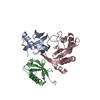
| |||||||||
|---|---|---|---|---|---|---|---|---|---|---|
| 1 |
| |||||||||
| NMR ensembles |
|
- Components
Components
| #1: Protein | Mass: 8604.845 Da / Num. of mol.: 1 / Mutation: K63R Source method: isolated from a genetically manipulated source Details: Distal domain of K63-linked diubiquitin. The K63R mutation is made to prevent formation of polyubiquitin during enzymatic linkage to the proximal domain. Joined to the proximal domain of ...Details: Distal domain of K63-linked diubiquitin. The K63R mutation is made to prevent formation of polyubiquitin during enzymatic linkage to the proximal domain. Joined to the proximal domain of diubiquitin at residue G76 using an isopeptide bond. Source: (gene. exp.)  Homo sapiens (human) / Gene: UBB / Production host: Homo sapiens (human) / Gene: UBB / Production host:  |
|---|---|
| #2: Protein | Mass: 8691.918 Da / Num. of mol.: 1 / Mutation: +D77 Source method: isolated from a genetically manipulated source Details: Proximal domain of K63-linked diubiquitin. The additional aspartic acid on the C-terminus (+D77) is made to prevent formation of polyubiquitin during enzymatic linkage to the distal domain. ...Details: Proximal domain of K63-linked diubiquitin. The additional aspartic acid on the C-terminus (+D77) is made to prevent formation of polyubiquitin during enzymatic linkage to the distal domain. Joined to the distal domain of diubiquitin at residue K63 using an isopeptide bond. Source: (gene. exp.)  Homo sapiens (human) / Gene: UBB / Production host: Homo sapiens (human) / Gene: UBB / Production host:  |
| #3: Protein | Mass: 16633.352 Da / Num. of mol.: 1 Source method: isolated from a genetically manipulated source Source: (gene. exp.)  Homo sapiens (human) / Gene: TSG101 / Plasmid: pET-28B / Production host: Homo sapiens (human) / Gene: TSG101 / Plasmid: pET-28B / Production host:  |
| Has protein modification | Y |
-Experimental details
-Experiment
| Experiment | Method: SOLUTION NMR | ||||||||||||||||||||||||||||||||||||||||||||||||||||||||||||||||||
|---|---|---|---|---|---|---|---|---|---|---|---|---|---|---|---|---|---|---|---|---|---|---|---|---|---|---|---|---|---|---|---|---|---|---|---|---|---|---|---|---|---|---|---|---|---|---|---|---|---|---|---|---|---|---|---|---|---|---|---|---|---|---|---|---|---|---|---|
| NMR experiment |
|
- Sample preparation
Sample preparation
| Details |
| |||||||||||||||||||||||||||||||||||||||||||||||||||||||||||||||||||||||||||
|---|---|---|---|---|---|---|---|---|---|---|---|---|---|---|---|---|---|---|---|---|---|---|---|---|---|---|---|---|---|---|---|---|---|---|---|---|---|---|---|---|---|---|---|---|---|---|---|---|---|---|---|---|---|---|---|---|---|---|---|---|---|---|---|---|---|---|---|---|---|---|---|---|---|---|---|---|
| Sample |
|
 Movie
Movie Controller
Controller


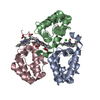

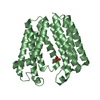
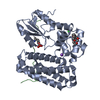
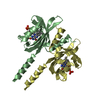
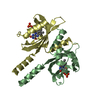
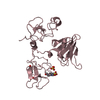
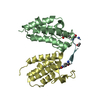

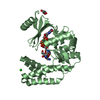
 PDBj
PDBj
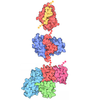










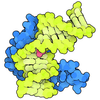

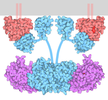



 HSQC
HSQC